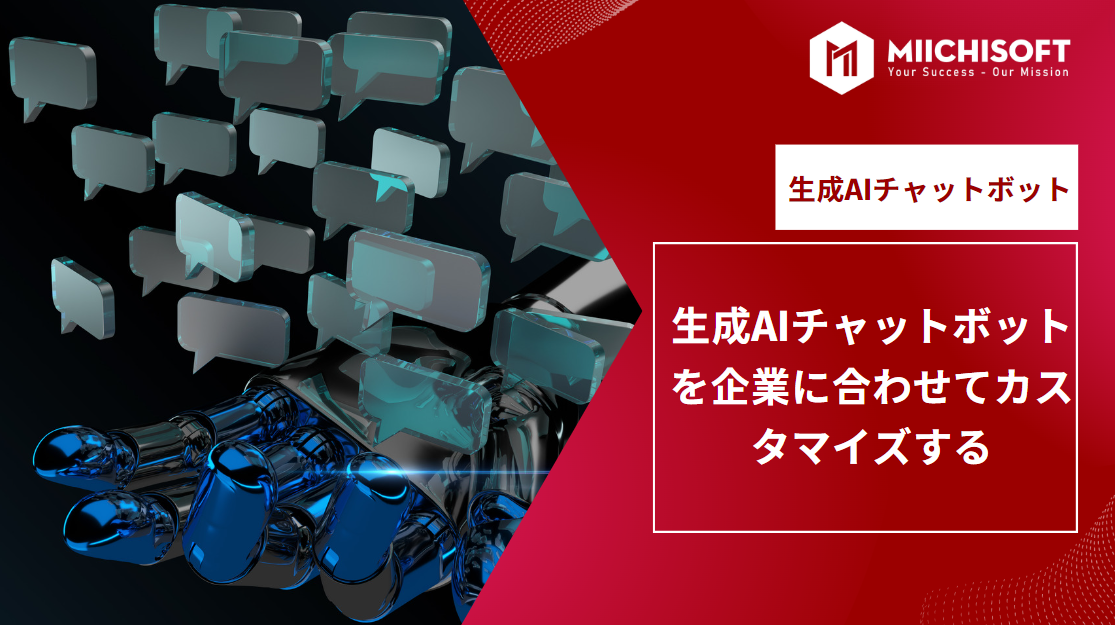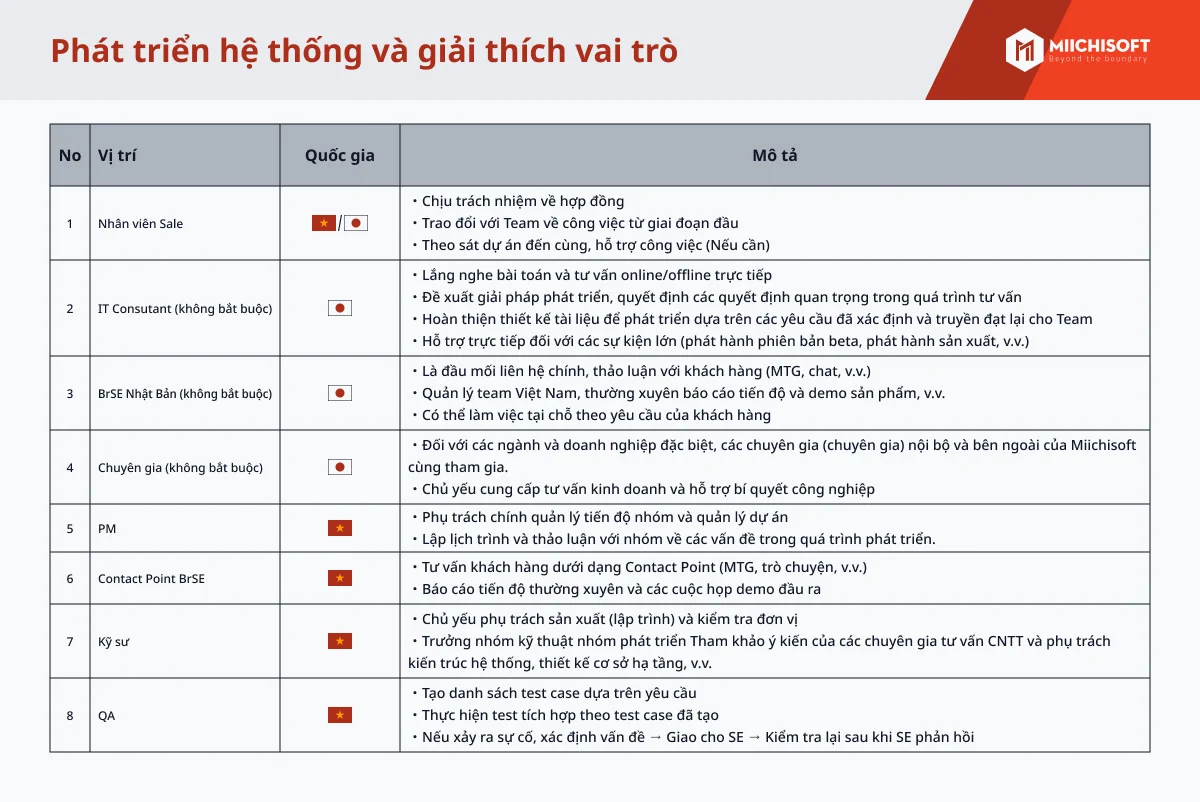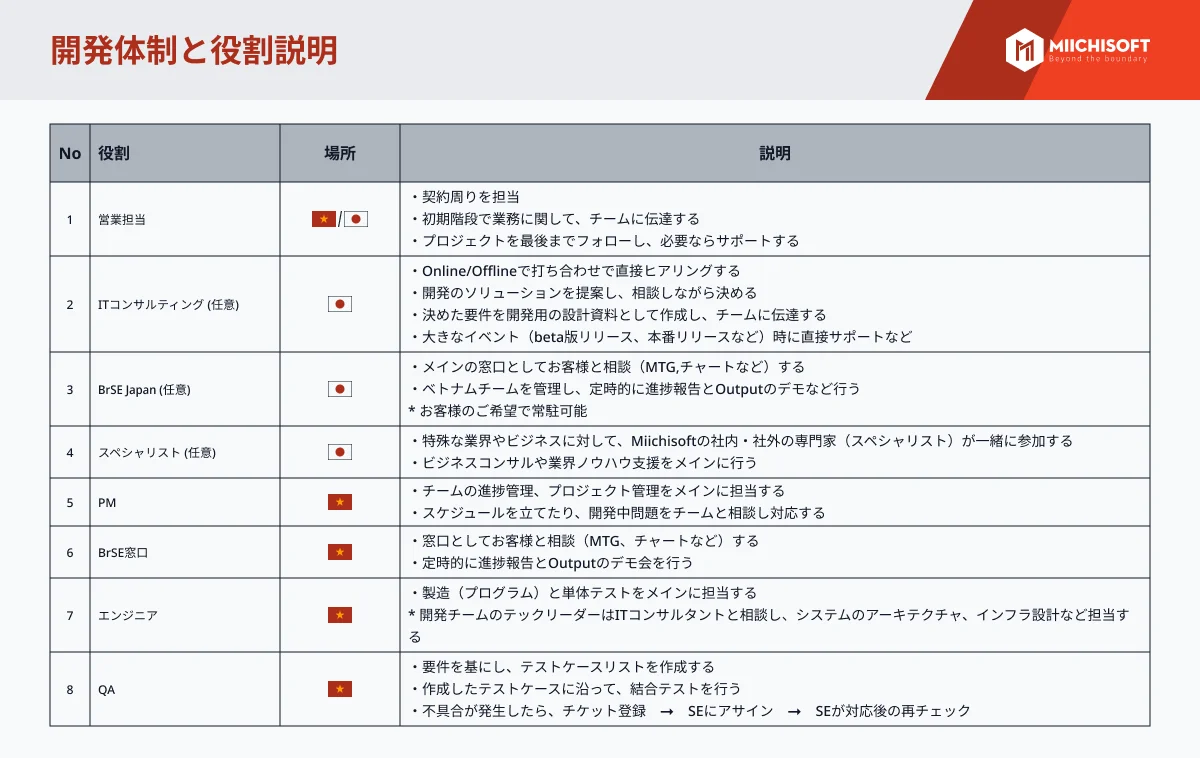近年、生成 AI(人工知能)技術の発達により、チャットボットの機能や性能が大きく進化しています。従来のルールベースのチャットボットに加え、自然言語処理能力を備えた生成 AIチャットボットが登場し、企業のカスタマーサポートや業務効率化の実現に大きな可能性をもたらしています。
本記事では、チャットボットと生成 AIチャットボットの違いを詳しく解説し、生成系AIチャットボットの導入メリットや成功のポイントを分かりやすくご紹介します。企業が生成 AIチャットボットを効果的に活用するためのヒントが満載ですので、ぜひ参考にしてみてください。

生成 AI チャット ボット vs. 従来型チャットボット: 徹底比較
1.チャットボット・AI・生成AIの概要
1.1. チャットボットとは
チャットボットとは、テキストや音声による対話を通じて、ユーザーからの質問や要求に応答するシステムのことです。ウェブサイトやアプリ、メッセージングツールなどに組み込まれ、ユーザーからの問い合わせに自動で対応することができます。
Chatbot の主な特徴は以下の通りです。
+ 24時間365日対応可能
+ 同時に複数のユーザーに対応可能
+ FAQ(よくある質問)への迅速な対応が可能
+ オペレーターに代わって簡単な作業を代行可能
実際に、多くの企業がカスタマーサポートの分野でチャットボットを活用しています。大手通信会社のソフトバンクでは、「おしえてソフトバンク」と呼ばれるChatbotを運用し、契約手続きや料金プランの説明などに活用しています。

チャットボット導入の重要性
1.2. AIとは
AIとは、人工知能 (Artificial Intelligence) の略称です。人間の知的能力を模倣したコンピューターシステムやソフトウェアの総称を指します。AIには、機械学習、深層学習、自然言語処理、画像認識、音声認識などの技術が含まれます。
AIは、与えられたデータから規則性を発見し、その規則に基づいて推論や判断を行うことができます。つまり、人間と同様に「学習」する能力を持っているのが大きな特徴です。従来のプログラミングとは異なり、AIは経験からスキルを身につけ、パフォーマンスを向上させることができるのです。
AIの具体的な活用例としては、以下のようなものがあげられます。
+ 自動運転車の開発
+ 医療診断の支援
+ 金融取引の自動化
+ 自然言語処理を活用したチャットボット構築
+ 画像や音声の認識
AIは様々な分野で活用が進んでおり、今後ますますその重要性が高まっていくことが予想されています。従来のチャットボットにはAI技術が搭載されていないものが多く、設定された決まった文章に沿った対応しかできませんでした。しかし、AIの自然言語処理技術の進化により、よりスムーズで自然なコミュニケーションが可能になってきています。
1.3. 生成AIとは
AIは、機械学習などの技術を用いて、与えられたデータから規則性を見つけ出し、推論や判断を行うことができます。
一方、生成AIとは、AIの中でも特に自然言語生成(Natural Language Generation、NLG)技術に長けた製品のことを指します。NLG技術を活用し、人間とリアルタイムで自然な対話を行うことができます。機械学習モデルにさまざまな対話データを学習させることで、ユーザーの発言を的確に理解し、適切な返答を生成することができます。
このようにして、生成AIがビジネスに応用され、企業の顧客開拓を効果的に支援する強力なツールとなっています。以下の記事では、生成AIがお客様のビジネスを支援する8つの方法をご紹介いたします。「生成AIがビジネスのパフォーマンスを向上させる8つの方法」
AIと生成AIの違い
つまり、AIは広く人間の知能を模倣する技術分野全般を指し、生成AIはその中でも自然言語処理、特に自然言語生成に特化した製品を指すということができます。生成AIは、より自然な対話を実現できるのが大きな特徴です。
2. チャットボットの種類
近年のトレンドは、チャットボットがWebサイトの必須ツールとなりつつあるのものである。本セクションでは、チャットボットの2つの種類について解説します。
チャットボットは、大きく分けて2種類に分類できます。

チャットボットの2種類
2.1. 【チャットボット】 (生成AI非搭載型チャットボット)
2.1.1. チャットボット (生成AI非搭載型チャットボット)とは?
生成AI非搭載型チャットボットとは、従来から存在する一般的なチャットボットのことを指します。あらかじめ設定された決まったルールやパターンに基づいて回答を出力するシステムです。AIの自然言語処理技術は搭載されていません。
生成AI非搭載型チャットボットでは、管理者があらかじめ多数の質問パターンと回答パターンをデータベースに登録しておきます。そして、ユーザーから入力された質問文と登録済みの 質問パターンとのマッチング精度を計算し、最も類似度が高い質問パターンに紐づいた回答を返すという仕組みになっています。
2.1.2. チャットボットのメリット
生成AI非搭載型チャットボットを導入するメリットは、以下の2点が挙げられます。
+ 低コストで導入が可能: 生成AI非搭載型チャットボットは比較的シンプルな構造のため、導入コストを抑えることができます。生成AI搭載型チャットボット (Gen AI Chatbot) に比べ、初期費用が大幅に安価です。
+ 社内で構築・運用が可能: 専門的な知見がなくても、社内でチャットボットを構築・運用することが可能です。自社のノウハウやFAQデータを活用しながら、質問と回答のデータベースを自身で作成できます。
2.1.3. チャットボットのデメリット
一方、生成AI非搭載型チャットボットには以下のようなデメリットもあります。
+ 対応範囲が限定的: 回答データをいくら増やしても、登録されたパターン以外への対応は難しいのが現状です。ユーザーの質問によっては適切に回答できない場合があります。
+ 長期的なサポートが受けにくい: 生成AI非搭載型チャットボットは売り切り型のツールが多く、導入後の運用サポートを受けにくいケースがあります。定期的なメンテナンスが必要になる点も課題です。
+ 非効率的なデータ登録作業: 質問と回答のパターンを一つひとつ手作業で登録していく必要があり、スケーリングが難しいというデメリットがあります。
次に、最新の生成AI技術を搭載した生成系AIチャットボットの特徴や具体的な製品事例について解説していきます。生成AI非搭載型と比較しながら、より高度な対話を実現できる生成AI会話ボットの強みを分かりやすく説明します。
2.2. 【生成 AI チャット ボット】- Generative AI chatbot
2.2.1. 生成 AI チャットボットとは?
生成AIチャットボットとは、AIの自然言語生成(NLG)技術を活用したチャットボットのことを指します。機械学習モデルに大量の過去の対話データを学習させ、ユーザーの発言の意図を理解した上で、自然で適切な応答を自動で生成することができます。
2.2.2. 生成 AI チャットボットのメリット
生成AI対話ボットを導入することで、以下のようなメリットが期待できます。
+ 自然な対話が可能: 人工知能ならではの優れた言語処理能力により、ユーザーの発言をきめ細かく理解し、人間とスムーズでなめらかな対話を実現できます。回答がロボット調ではなく、ユーザーにストレスを与えません。
+ 幅広い質問へ対応可能: 過去の対話データを学習しているため、設定されたパターン以外の質問にも適切に対応できます。質問への回答範囲が格段に広がります。
さらに、生成 AI 対話ボットは学習することで、応対力を常に進化させていきます。ユーザーの対話履歴を分析し、よりスムーズなコミュニケーションができるよう自己学習を重ねていくのです。このようにAIチャットボットは、ユーザーにとってストレスフリーで利便性の高いサポート体験を実現してくれます。
2.2.3. 生成 AI チャット ボットのデメリット
ただし、生成系AIチャットボットにはデメリットがあります。人工 知能 チャットを導入する際のデメリットは以下のようなものが考えられます。
+ 高額な初期導入コスト: 生成AIのモデルを構築するには、大量の対話データを収集し、モデルの学習が必要になります。専門的な技術とリソースが必要で、導入コストが高額になる可能性があります。
+ 継続的な運用コスト: モデルの性能を維持・改善していくために、定期的に新しいデータでの再学習が欠かせません。継続的な運用コストがかかるというデメリットがあります。多くの場合で、専任のエンジニアが必要となり、運用コストもかさみます。
+ ある程度のチェック体制が必要: エラー防止のため、生成された応答内容を事前に確認・修正する体制を整備する必要があります。
3. Generative AI Chatbot導入の準備
Generative AI Chatbotを導入する際、うまくいかないのかという懸念もあります。人間の対応には多くの複雑な処理が含まれており、それをすべてチャットボットで再現するのは極めて困難です。個別の事情への対応や、人間関係への配慮など、人間ならではの気配りが必要となります。導入時の準備が不十分だと、ユーザーの期待に添えない場合が多いです。そのため、チャットボットを無理なく導入するには、企業側で以下のような準備が必要となります。
+ 十分なデータの収集と整備
Gen AI Chatbot の精度は学習データの質と量に大きく依存します。企業独自の用語や文脈を適切に反映したデータが不足していると、期待通りの応答ができません。業界用語、FAQ、製品情報、過去の問い合わせ履歴など、幅広くデータを収集し、学習用デー タセットとして適切に加工することが重要です。
+ 既存システムとの円滑な統合
生成AIチャットボットを円滑に運用するには、既存のシステム(CRM、データベース等)との連携が不可欠です。システム統合が不十分だと、効率的な業務フローが実現できません。APIやその他の手段を用いて、AI対話ボットと既存のシステムを確実に連携させる必要があります。システム間のデータ受渡しが円滑に行える環境を構築する必要があります。
+ 継続的な訓練とモニタリングが必須
AI対話ボットを成功させるには、事前の綿密な準備と、導入後の継続的な改善が欠かせません。そのため、生成AIチャットボットの稼働状況を常にモニタリングし、定期的に評価できるプロセスを構築する必要があります。フィードバックに基づきデータの再学習を行う体制も重要になります。
4. MiichisoftのdxGAIチャットボットのご紹介:お手伝いさせてください!
4.1. dxGAIチャットボットとは?
dxGAIチャットボットはMiichisoftの開発した生成AI及びRetrieval Augmented Generation (RAG)という最先端のテクノロジーを搭載した高性能ソリューションです。
*Retrieval Augmented Generation (RAG)のは、大規模な非構造化データから関連情報を取得し、生成モデルにその情報を渡すことで、詳細で的確な応答を生成することができます。RAGは情報検索(Retrieval)とテキスト生成モデル(Generation)の組み合わせです。言い換えれば、それは大規模言語モデル(LLM)の動作方法における空白を埋めるものです。従来のAIチャットボットよりも、はるかに高い応答精度が期待できます。
MiichisoftのdxGAIチャットボット
4.2. dxGAIチャットボットの特長
MiichisoftのdxGAIチャットボットの特長は下の通りであります。
+ UIのカスタマイズ可能性: dxGAIのUIは、企業のブランドイメージに合わせて自由にカスタマイズが可能です。ロゴ、フォント、色など様々な要素を調整できます。
+ 導入の容易さ: dxGAIチャットボットは、クラウドベースのソリューションであり、導入が非常に簡単です。特別なインフラ整備は不要で、短期間での運用開始が可能です。
+ 多彩なツール/プラットフォームとの連携: dxGAIチャットボットは、Webサイトはもちろん、さまざまなツール(Salesforce、ZenDesk、Microsoft Teams、LINE、Slackなど)やプラットフォーム(iOS、Androidなど)と連携可能です。
+ 詳細な分析機能: dxGAIチャットボットには、利用状況や応答のパフォーマンスを分析するための高度な分析機能が装備されています。改善点の特定やROIの算出に役立ちます。そのdxGAIチャットボットの高度な分析機能は、チャットボットと顧客との相互作用に関するデータとレポートを整理し、チャットボットの効果を向上させるために有益であります。
+ 80以上の言語対応:dxGAIは80を超える言語に対応しており、グローバル企業のニーズにも十分に応えられます。
4.3. dxGAIチャットボットの提供する価値
で、貴社のビジネスに対して、MiichisoftのdxGAIチャットボットはどんな価値を提供できますか。
+ dxGAIチャットボットが 正確で信頼できる応答を作成する
- RAGテクノロジーを活用したdxGAIは、大量のデータから関連情報を的確に抽出し、質の高い応答を生成します。信頼できる情報提供が可能です。
- 多様な外部データソース(技術文書、業界データなど)の活用 、また、企業の内部のデータ(FAQ、製品情報、ナレッジベースなど) 流合ができるdxGAIは、企業や業界に特化した高度な知識を有することができます。
- さらに、継続的な自動学習 dxGAIは利用者との対話を通じて継続的に学習し、性能を高めていきます。定期的な再学習も可能で、常に最新の知識を提供できます。そこで、顧客様のニーズに最も正確で信頼できる応答をていきょうできます。
+ dxGAIチャットボットがリードジェネレーションを支援できる
- 潜在顧客のデータを収集し、それを元に「カスタマージャーニーマップ」に従ってパーソナライズされた購入体験を提供します。
+ dxGAIチャットボットがデータのプライバシーとセキュリティを保証する
- dxGAIは企業データの機密性を最大限に尊重し、業界最高水準のセキュリティ対策を施しています。安心して導入できるソリューションです。
5. 結論
チャットボットと生成AI チャット ボットの大きな違いは、自然言語処理能力の有無にあります。従来のルールベースのチャットボットは、あらかじめ設定された定型文からの回答しかできませんでした。
一方、生成AIチャットボットは自然言語をある程度理解し、状況に応じた回答を生成できます。しかし一方で、課題もあります。回答の質を高めるための大量のデータと学習が必要不可欠です。また、AIの応答にバイアスがかかる可能性もあり、モニタリングが欠かせません。
Miichisoft では、RAGテクノロジーと生成AI技術に基づいたdxGAIチャットボットソリューションを開発しています。この AIソリューションは、カスタマーサービスでの利用に加え、企業の研修活動と社内広報の最適化を支援する社内自動FAQでも活用されています。
多くの企業が収益拡大のためにAIを導入することを目指していることを理解していますが、自分で最初から最後までAIを導入するのは非常に難しい可能性があります。そこでMiichisoftの専門家が、お客様と共に歩み、企業の目標に合ったAIモデルを構築し、生産性の向上、コスト削減、競争力の強化をサポートいたします。Miichisoftに導入をお任せください!




















